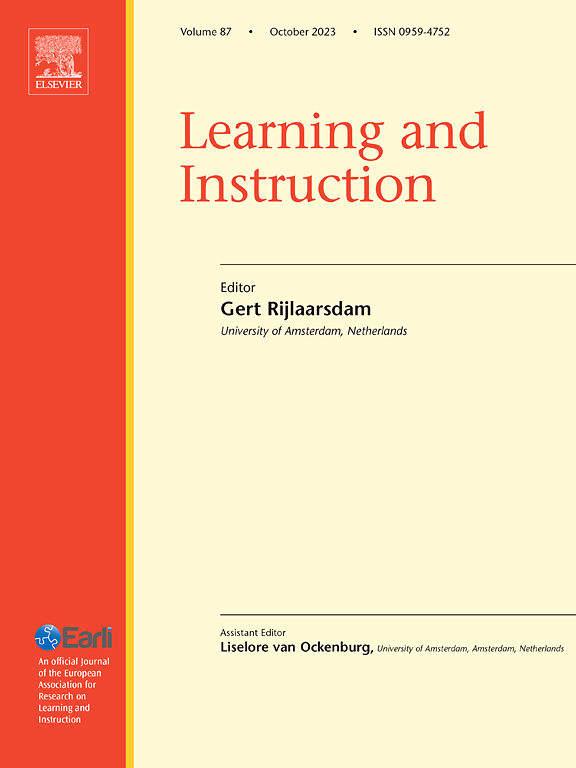检查每周降低微积分成本的干预措施
IF 4.9
1区 教育学
Q1 EDUCATION & EDUCATIONAL RESEARCH
引用次数: 0
摘要
虽然成本观念被认为是可能破坏学术参与的关键动机信念,但很少有研究设计或测试干预措施来降低学生的成本观念。我们开发、实施并评估了每周成本降低干预措施,利用激励调节策略来降低成本。样本参与者为449名微积分本科生。方法采用预先注册的随机对照试验,将学生分为成本降低组和对照组,连续13周。在降低成本的条件下,学生们思考一系列激励调节策略,并写下他们将如何在接下来的一周使用特定策略。结果干预显著降低了所有学生的每周任务努力成本、每周情感成本、最终任务努力成本、最终有价值选择损失成本和最终情感成本。然而,相互作用分析显示,益处通常仅限于特定群体,与预先登记的初步假设一致。与对照组相比,干预组的种族边缘化学生报告的每周情绪成本、每周兴趣、最终任务努力成本和最终情绪成本均较低;这些影响在非种族边缘化的学生中没有出现。此外,与对照组相比,干预组高中gpa较低的学生报告了更高的STEM职业意向,只有高中gpa较高的学生报告了更低的每周外部努力成本。结论统计上显著的效果表明每周成本降低干预对帮助一些学生学习的潜力。本文章由计算机程序翻译,如有差异,请以英文原文为准。
Examining a weekly cost reduction intervention in calculus
Background
Though cost perceptions are thought to be key motivational beliefs that can undermine academic engagement, little research has designed or tested interventions to reduce cost perceptions for students.
Aims
We developed, implemented, and evaluated a weekly cost reduction intervention utilizing motivational regulation strategies to reduce cost.
Sample
Participants were 449 undergraduate calculus students.
Methods
Using a pre-registered randomized controlled trial, students were assigned to a cost reduction condition or control condition for 13 consecutive weeks. In the cost reduction condition, students reflected on a list of motivational regulation strategies and wrote about how they would use a specific strategy the following week.
Results
The intervention significantly reduced weekly task effort cost, weekly emotional cost, final task effort cost, final loss of valued alternatives cost, and final emotional cost on average for all students. However, interaction analyses revealed that benefits were often limited to specific groups, aligning with tentative pre-registered hypotheses. Racially marginalized students in the intervention reported lower weekly emotional cost, higher weekly interest, lower final task effort cost, and lower final emotional cost, compared to racially marginalized students in the control condition; these effects did not appear among non-racially-marginalized students. Additionally, students with lower high school GPAs in the intervention reported higher STEM career intentions and only students with higher high school GPAs reported lower weekly outside effort cost compared to their counterparts in the control condition.
Conclusions
The statistically significant effects demonstrate the potential of weekly cost reduction interventions for helping some students with their learning.
求助全文
通过发布文献求助,成功后即可免费获取论文全文。
去求助
来源期刊

Learning and Instruction
Multiple-
CiteScore
11.30
自引率
4.80%
发文量
109
期刊介绍:
As an international, multi-disciplinary, peer-refereed journal, Learning and Instruction provides a platform for the publication of the most advanced scientific research in the areas of learning, development, instruction and teaching. The journal welcomes original empirical investigations. The papers may represent a variety of theoretical perspectives and different methodological approaches. They may refer to any age level, from infants to adults and to a diversity of learning and instructional settings, from laboratory experiments to field studies. The major criteria in the review and the selection process concern the significance of the contribution to the area of learning and instruction, and the rigor of the study.
 求助内容:
求助内容: 应助结果提醒方式:
应助结果提醒方式:


